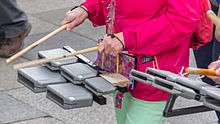Temple block


The temple block is a percussion instrument originating in eastern Asia, where it is used in religious ceremonies.
It is a carved hollow wooden instrument with a large slit. In its traditional form, the wooden fish, the shape is somewhat bulbous; modern instruments are also used which are rectangular in shape. Several blocks of varying sizes are often used together to give a variety of pitches. In Western music, their use can be traced back to early jazz drummers, and they are also used in modern orchestral music, where they are also called dragons' mouths.
The sound of temple blocks is similar to that of wood blocks, although temple blocks have a darker, more "hollow" timbre.
Temple blocks can be heard in Leroy Anderson's The Syncopated Clock. Olivier Messiaen used them in his only symphony, Turangalîla, and his only opera, Saint-François d'Assise. Harrison Birtwistle calls for four temple blocks in his 2008 opera The Minotaur, Magnus Lindberg calls for five in Seht die Sonne, and Pierre Boulez for one in Notations I-IV. Leonard Bernstein, George Benjamin and David Horne also used it in their compositions. The rock band Rush featured temple blocks in their songs "Xanadu" and "The Trees," played by drummer Neil Peart.
An updated version of traditional wooden temple blocks are so-called granite blocks. Despite the name, they not made of stone, but of waterproof plastic.